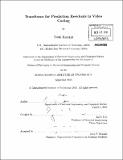| dc.contributor.advisor | Jae S. Lim. | en_US |
| dc.contributor.author | Kamışlı, Fatih | en_US |
| dc.contributor.other | Massachusetts Institute of Technology. Dept. of Electrical Engineering and Computer Science. | en_US |
| dc.date.accessioned | 2011-04-25T15:56:36Z | |
| dc.date.available | 2011-04-25T15:56:36Z | |
| dc.date.copyright | 2010 | en_US |
| dc.date.issued | 2010 | en_US |
| dc.identifier.uri | http://hdl.handle.net/1721.1/62424 | |
| dc.description | Thesis (Ph. D.)--Massachusetts Institute of Technology, Dept. of Electrical Engineering and Computer Science, 2010. | en_US |
| dc.description | Cataloged from PDF version of thesis. | en_US |
| dc.description | Includes bibliographical references (p. 135-140). | en_US |
| dc.description.abstract | Typically the same transform, the 2-D Discrete Cosine Transform (DCT), is used to compress both image intensities in image coding and prediction residuals in video coding. Major prediction residuals include the motion compensated prediction residual, the resolution enhancement residual in scalable video coding, and the intra prediction residual in intra-frame coding. The 2-D DCT is efficient at decorrelating images, but the spatial characteristics of prediction residuals can be significantly different from the spatial characteristics of images, and developing transforms that are adapted to the characteristics of prediction residuals can improve their compression efficiency. In this thesis, we explore the differences between the characteristics of images and prediction residuals by analyzing their local anisotropic characteristics and develop transforms adapted to the local anisotropic characteristics of some types of prediction residuals. The analysis shows that local regions in images have 2-D anisotropic characteristics and many regions in several types of prediction residuals have 1-D anisotropic characteristics. Based on this insight, we develop 1-D transforms for these residuals. We perform experiments to evaluate the potential gains achievable from using these transforms within the H.264 codec, and the experimental results indicate that these transforms can increase the compression efficiency of these residuals. | en_US |
| dc.description.statementofresponsibility | by Fatih Kamışlı. | en_US |
| dc.format.extent | 140 p. | en_US |
| dc.language.iso | eng | en_US |
| dc.publisher | Massachusetts Institute of Technology | en_US |
| dc.rights | M.I.T. theses are protected by
copyright. They may be viewed from this source for any purpose, but
reproduction or distribution in any format is prohibited without written
permission. See provided URL for inquiries about permission. | en_US |
| dc.rights.uri | http://dspace.mit.edu/handle/1721.1/7582 | en_US |
| dc.subject | Electrical Engineering and Computer Science. | en_US |
| dc.title | Transforms for prediction residuals in video coding | en_US |
| dc.type | Thesis | en_US |
| dc.description.degree | Ph.D. | en_US |
| dc.contributor.department | Massachusetts Institute of Technology. Department of Electrical Engineering and Computer Science | |
| dc.identifier.oclc | 710987360 | en_US |
